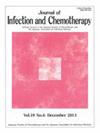Treatment of Stenotrophomonas malthophilia bloodstream infections from guidance to real life: multicenter retrospective cohort study
IF 1.5
4区 医学
Q3 INFECTIOUS DISEASES
引用次数: 0
Abstract
Objectives
Infectious Diseases Society of America guidance recommend the use of combination therapy (CT) for the treatment of Stenotrophomonas maltophilia (SM) infections. The aims of our study are to describe therapeutical management of patients with SM bloodstream infections (SM-BSI) and to evaluate the impact of antibiotic CT compared to monotherapy (MT) on 30-days mortality.
Methods
Multicenter, retrospective study of patients with SM-BSI hospitalized in 14 centers between January 2021–December 2022. Multivariable logistic regression analysis was performed to assess the risk factors for 30-days mortality including CT therapy as main exposure. To address potential confounding, an inverse probability of treatment weighting (IPTW) approach was used.
Results
64 patients with SM-BSI analyzed: 32 (50 %) male, median age of 65 years (IQR: 55–75). MT was administered in 49 patients (76.6 %) and CT in 15 (23.4 %). Trimethoprim/sulphamethoxazole was the most frequent drug used in both MT and CT. Levofloxacin was the second preferred MT. Patients receiving CT were more frequently admitted in ICU with septic shock at BSI onset. At multivariable analysis, septic shock (OR: 7.65, 95 %CI: 1.32–44.48, p = 0.023) and haematological malignancies (OR: 6.82, 95 %CI: 1.50–30.88, p = 0.013) were independent risk factors for 30-day mortality. Using an IPTW-based multivariable analysis, CT showed a non-significant trend toward a protective effect on 30-day mortality (OR: 0.88; 95 % CI: 0.23–3.42; p = 0.855).
Conclusions
CT for SM-BSI is used in a minority of cases in our cohort, representing the worst clinical scenarios. Further evidence is needing to confirm the impact of CT on outcome.
嗜麦芽寡养单胞菌血液感染的治疗从指导到现实生活:多中心回顾性队列研究。
目的:美国传染病学会指南推荐使用联合治疗(CT)治疗嗜麦芽窄养单胞菌(SM)感染。我们研究的目的是描述SM血流感染(SM- bsi)患者的治疗管理,并评估抗生素CT与单药治疗(MT)相比对30天死亡率的影响。方法:对2021年1月至2022年12月14个中心住院的SM-BSI患者进行多中心回顾性研究。采用多变量logistic回归分析评估以CT治疗为主要暴露点的30天死亡率危险因素。为了解决潜在的混淆,使用了治疗加权逆概率(IPTW)方法。结果:分析64例SM-BSI患者:32例(50%)男性,中位年龄65岁(IQR: 55-75)。49例(76.6%)行MT, 15例(23.4%)行CT。甲氧苄啶/磺胺甲恶唑是MT和CT中最常用的药物。左氧氟沙星是第二首选的MT。接受CT治疗的患者在BSI发病时脓毒性休克入住ICU的频率更高。在多变量分析中,感染性休克(OR: 7.65, 95%CI: 1.32-44.48, p=0.023)和血液恶性肿瘤(OR: 6.82, 95%CI: 1.50-30.88, p= 0.013)是30天死亡率的独立危险因素。使用基于iptw的多变量分析,CT显示对30天死亡率的保护作用无显著趋势(OR: 0.88;95% ci: 0.23-3.42;P = 0.855)。结论:CT检查SM-BSI在我们队列中的少数病例中使用,代表了最糟糕的临床情况。需要进一步的证据来证实CT对预后的影响。
本文章由计算机程序翻译,如有差异,请以英文原文为准。
求助全文
约1分钟内获得全文
求助全文
来源期刊

Journal of Infection and Chemotherapy
INFECTIOUS DISEASES-PHARMACOLOGY & PHARMACY
CiteScore
4.10
自引率
4.50%
发文量
303
审稿时长
47 days
期刊介绍:
The Journal of Infection and Chemotherapy (JIC) — official journal of the Japanese Society of Chemotherapy and The Japanese Association for Infectious Diseases — welcomes original papers, laboratory or clinical, as well as case reports, notes, committee reports, surveillance and guidelines from all parts of the world on all aspects of chemotherapy, covering the pathogenesis, diagnosis, treatment, and control of infection, including treatment with anticancer drugs. Experimental studies on animal models and pharmacokinetics, and reports on epidemiology and clinical trials are particularly welcome.
 求助内容:
求助内容: 应助结果提醒方式:
应助结果提醒方式:


